I get asked this a lot…
“What’s the difference between a Community Manager and a Social Media Manager?”
Many of you are growing your team (yay!), and have figured out the importance of hiring the correct person for the correct job.
Hiring for the wrong position when it comes to a Community Manager and/or Social Media Manager can be detrimental to…
- your company expectations,
- your new hire’s sanity level,
- the ability to scale your social and community teams effectively
…so let’s get this sorted out BEFORE you make your job openings live.
Today, I’m breaking down both of these roles so you can make sure you hire right the first time.
(RELATED: 6 Trending Digital Marketing Skills to Put on a Resume)
The Magic Question
Identifying the difference is as easy as answering one simple (one might even say, “magic”) question:
Who is your [Social Media/Community] Manager talking to?
Marketing professionals know the importance of this question. The success or failure of a message begins and ends with putting that message in front of the right people.
If you can’t define who your new hire is talking to, chances are that position is not well defined, and it should be fleshed out a little more.
Don’t get me wrong, it can be confusing.
Social Media Managers and Community Managers both strive to provide a human element to a company’s online presence and can often use the same social media platform to do so… but when push comes to shove, they speak to entirely different groups.
Social Media Managers speak to an audience on behalf of your company…
An audience as a specific group of people who are targeted recipients of your message.
Community Managers, on the other hand, speak to… well… your community!
Feverbee defines a community as “a specific group of people who have developed relationships around a strong common interest.”
Let’s dive a little deeper into this, shall we?
One easy way to determine if you are looking to manage an audience or a community is to ask yourself…
“Are my messages designed to start a conversation between me and my customer, or are they designed to get my customers talking to each other?”
Take, for instance, a typical Tweet from the folks over at Lowe’s.

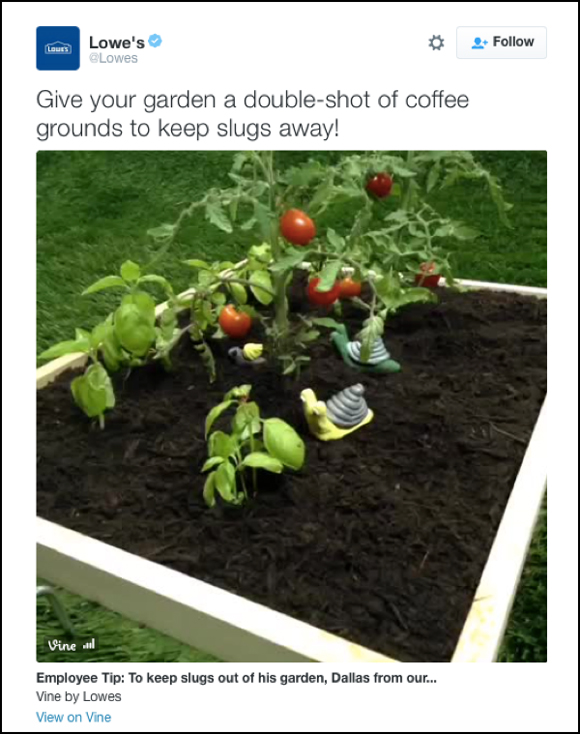
This is an example of Lowe’s speaking to its audience – a specific group of people (their followers) who are recipients of their message.
Take a look at the responses to this tweet:

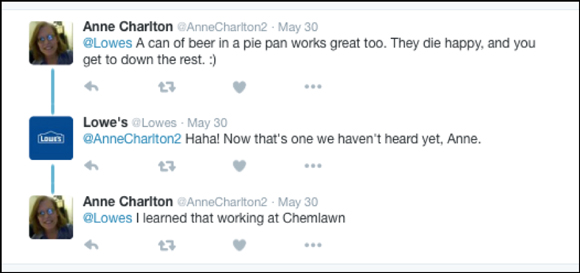
You don’t see any of Lowe’s followers having meaningful conversations with each other and building relationships around their fandom. And that’s okay – because this tweet wasn’t designed to encourage community-building behavior.
Social Media Managers and Community Managers can use the same platform, such as Twitter, to do their jobs – what matters is the purpose of the communication.
For instance, take a look at this Twitter chat from Buffer…

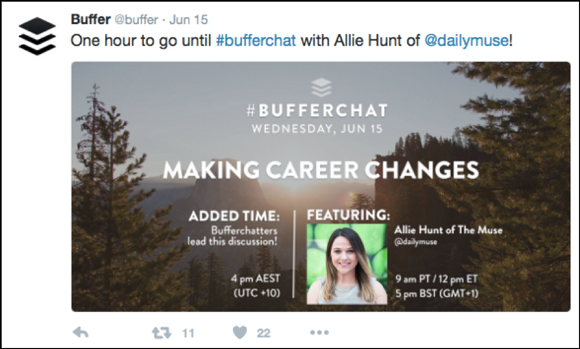
Look at how different the responses are from that of Lowe’s:

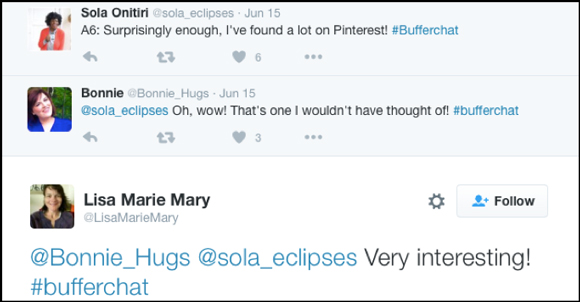

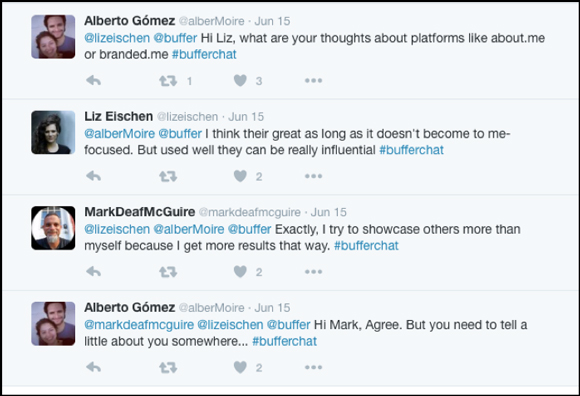
This is just a smidgen of an hour-long Twitter conversation between panelists and participants talking to panelists and connecting with each other.
This is much more of a community move than a standard social media strategy.
Think about how the manager you’re considering would talk to your customers/potential customers. If it’s mostly a company representative talking to your members and your members talking back to your company, it’s more likely that your hire is speaking to an audience. If communication is mostly your members talking to each other, that’s a community – and you need a Community Manager to facilitate and moderate those conversations.
Let’s talk Facebook groups for a minute.
Many companies are using Facebook groups to connect with their customers and are hiring Community Managers to fill the role. But is it a community?
It all depends on what kind of communication is happening.
If Coca-Cola had a Facebook group and only discussed promos, new can designs, and viral videos of amateur scientists dropping Mentos candies into coke bottles, they would be communicating with their audience.
Social Media Managers are often in charge of creating and curating these messages, measuring the results, and providing an engaging online brand for the company.
But what if Coca-Cola had a group for Coca-Cola memorabilia collectors?
What sort of things could the company talk about to help community members build relationships with each other and celebrate a shared passion for all things red and white? That’s where a Community Manager comes in.
Now that we know who each position talks to, let’s explore roles and responsibilities!
Community Managers: What They Do
A Community Manager’s main function is to create a healthy environment for members to connect with each other and facilitate, strengthen, and encourage those relationships. Their job isn’t to directly broadcast marketing messages, but to help members talk to each other.
Community Managers function as advocates. They advocate on behalf of the company to their members by representing the business on a very personal level. They also advocate on behalf of the customer, monitoring conversations and providing feedback to the company.
Common tasks of a Community Manager can include…
- Adding and removing members from the community
- Welcoming new members
- Establishing community culture
- Moderating community content
- Providing customer support to community members
- Gathering testimonials and feedback produced in the community
- Creating strategic content designed to build relationships between members
- Introducing community members to each other
- Developing and maintaining community guidelines and policies
- Hosting online and/or offline events for community members
Community Manager: How Is Success Measured?
Key Performance Indicators (KPIs) for your Community Manager will vary depending on the purpose of your community.
For example, a group like DigitalMarketer’s DM Engage Facebook group…


…will have a VERY different definition of success than a support community forum from Apple.


Generally speaking, community KPIs involve metrics that measure the community’s health and its effect on the company (read = ROI). What can be measured is also extremely dependent on the community platform – the KPIs that can be measured on an owned platform (such as Discourse, Jive, or Lithium) are almost impossible to measure on an unowned community like a Facebook group.
That being said, there are some common KPIs that are almost universal for measuring the success of community management:
- New visitors to your community. How many people visit your community page?
- New visitors to registered members. How many visitors actually sign up to be a part of the community?
- Percentage of active users. Do you have mostly lurkers (a term for community members who don’t actively engage in the community), or do members tend to contribute right off the bat?
- Active members in the last 30 days. Are you gaining or losing those active members?
- Number of contributions. How active are your members? No one likes a ghost town.
- How often do members visit your community? More visits means more contributions, which means a strong community.
- Retention rate. How long do members tend to remain in your community?
- Speed of replies to discussions. The more speed, the greater the level of participation (read = engagement).
- How many newcomers contribute? The only way a community grows is with contributions from new blood, so it’s important to make sure newbies don’t feel too intimidated to participate.
- Number of content/product gaps identified. Community Managers are intense listeners, and locating and resolving gaps in your company’s product and content through community discussion is key.
Once again, this is all very subjective to the purpose and platform of your community.
Customer support communities might also measure how many support tickets they diverted from the customer care department. Not-for-profit communities might measure how much money members contributed toward a goal.
It all depends on what your company has determined for community ROI.
A Day In The Life Of A Community Manager
Because there are all sorts of communities, my typical day, as DigitalMarketer’s Community Manger, would not be exactly the same as a typical day for a Community Manager at another company… but our end goal will be the same (if they were hired for the right position, that is).
Here’s a checklist of my general Monday at DigitalMarketer (times five, which is how many communities we have):
- Answer private messages and emails from community members.
- Read through posts and comments that I have been tagged to review, pointing people to helpful content, other members, or DM staff.

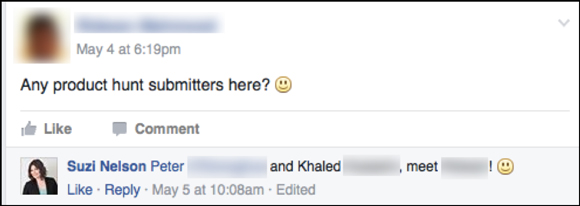
- Monitor community content for feedback loops.
- Search for strategic hashtags in the group and monitor conversations.
- Welcome new members and answer any questions they may have.

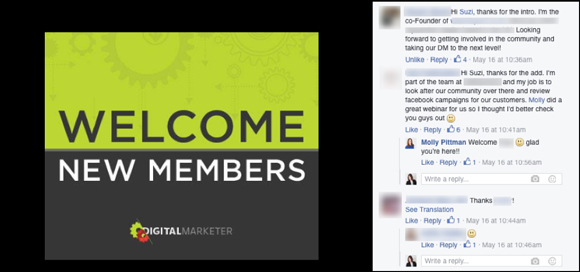
- Review any posts made over the weekend that have zero comments, and provide assistance or tag in community members who can help.
- Create the weekly accountability post, giving established members a chance to connect and newbies an easy opportunity to participate in the group.

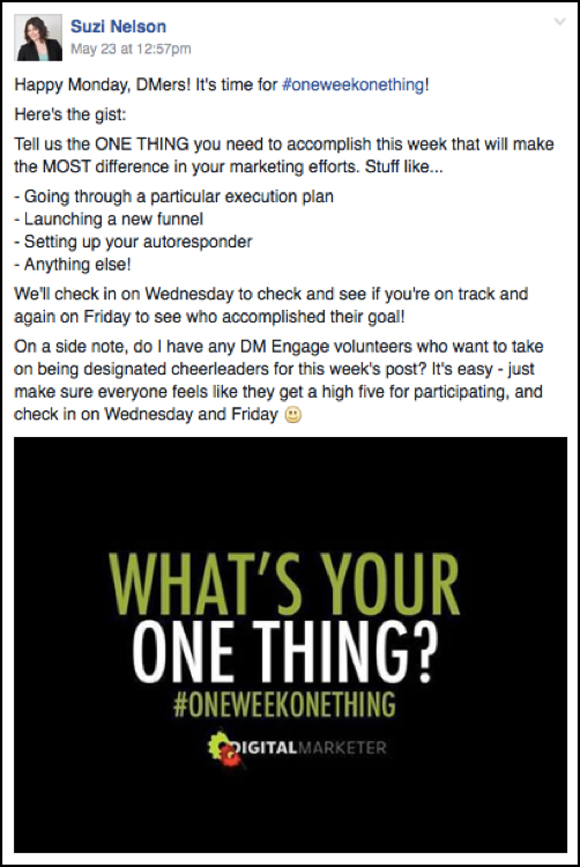
- Moderate posts and comments, making sure they are in line with our community guidelines. Reach out privately to anyone who broke the rules.
- Resolve any personal issues members might have with each other.
- Read through DigitalMarketer blog posts, podcast notes, and any other content I need to review to stay up-to-date on the latest content.
- Create a community event for our weekly Office Hours call and invite members to participate.
- Write thank-you notes to community leaders I see in the group.
- Post any applicable company announcements or news. I’ve found including puppy pictures has proven to increase engagement levels with our community members.

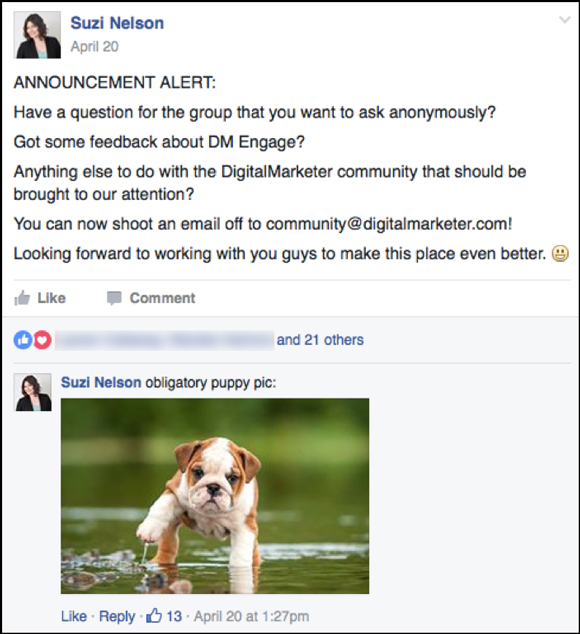
- Report any change of sentiment, content suggestion, or member feedback to the proper DM team member.
As you can see, the end result of my daily tasks includes advocating for and with members, being a general representative of DigitalMarketer, and facilitating communication and relationship-building between our members.
Now, let’s talk about…
What A Social Media Manager Does
Social Media Managers specialize creating a strong online presence for a brand by creating, distributing, and curating engaging content for an audience. Their main role is to connect with customers and potential customers and offer some sort of value in return for the members’ attention.
At DigitalMarketer, we categorize the roles of social media management into four parts:
- Social Listening: Monitoring and responding to customer service and reputation issues on the social web.
- Social Influencing: Establishing authority on the social web, often through the distribution and sharing of valuable and/or engaging content.
- Social Networking: Finding and associating with authoritative and influential individuals and brands on the social web.
- Social Selling: Generating leads and sales from existing customers and prospects on the social web.

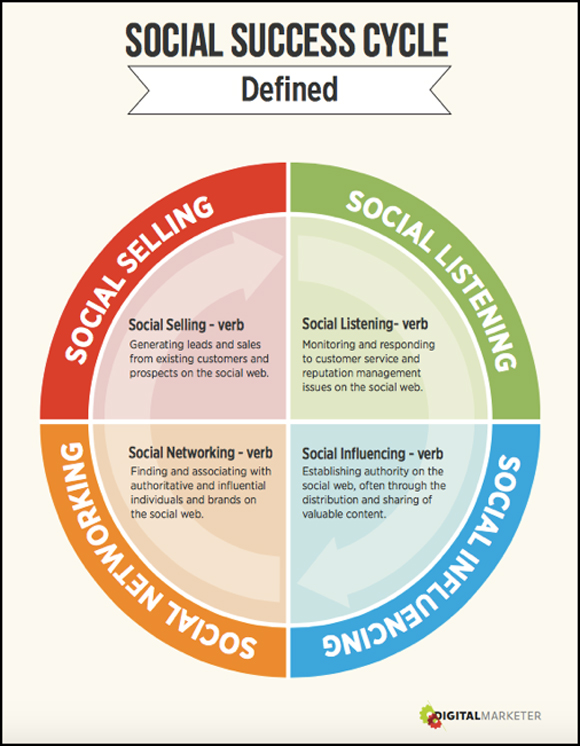
Common tasks a Social Media Manager might take on include…
- Creating and/or repurposing engaging content that establishes your company’s presence as an authority in your niche, such as blog posts, videos, graphics, etc.
- Responding to customers who voice their complaints on social media channels.
- Measuring sentiment about your company, products, and services on the social web and responding accordingly.
- Identifying key influencers and building goodwill by sharing their content with your audience.
- Sharing offers with your audience when appropriate.
Social Media Manager: How Is Success Measured?
The KPIs of a Social Media Manager can be similar to a Community Manager, but the company’s return on investment is centered on the effectiveness of the messages sent to the audience.
(RELATED: How to Measure Social Media Engagement)
Social media management metrics to track can include…
- Number of followers. Is your audience at a state of growth? While important to track, be mindful this is a vanity metric. There are more powerful indicators you have a successful social media strategy.
- Number of likes/shares/comments/retweets. How engaging does your audience find your content? This also falls under vanity metrics, but it’s still important to know how the audience is receiving your content.
- Visits to website from social channels. How effective is your content’s call-to-action?
- Reputation score. By providing social customer service and tracking the sentiment of your audience, a Social Media Manager is on the front lines of reputation management and identifying broader issues that may need to be addressed by the company.
- Retention/refund rate. A solid social media strategy will positively effect these rates.
- Number of content/product gaps resolved. Like Community Managers, Social Media Managers actively listen to their audience. How many gaps were identified and resolved
- Partnerships made. By curating short lists of key influencers and reaching out through the social web, Social Media Managers are key in creating mutually beneficial connections with authority figures and industry leaders.
- Number of inbound links and earned media mentions. While this info is more qualitative than quantitative, this number should increase with an effective social media strategy.
Where Community Managers are measured by the growth and health of member relationships (with each other and with the company), the metrics used to measure the success of Social Media Managers center around content, networking, and the influence your brand has on the social web.
A Day In The Life of a Social Media Manager
I had Jess Lonett, our Social Media Manager here at DigitalMarketer, share her typical day with me. Here’s what her typical day looks like:
- Respond to private messages from customers and prospects on Facebook and Twitter.
- Monitor ad comments, providing customer care when needed and removing any spam or trolls (a person who deliberately posts inflammatory statements on social platforms in the hopes of provoking an emotional response from others, often for their own amusement).
- Review social media alerts using Mention, which is set up to monitor social media mentions of our brand, products, and public-facing staff.

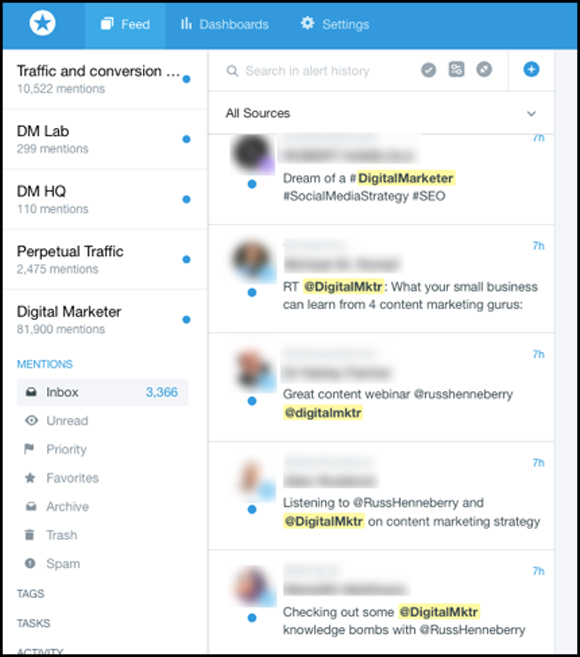
- Respond to posts and tweets, congratulate people who have passed one of the Mastery courses with the perfect gif, directing people to customer care, and retweeting mentions when applicable.

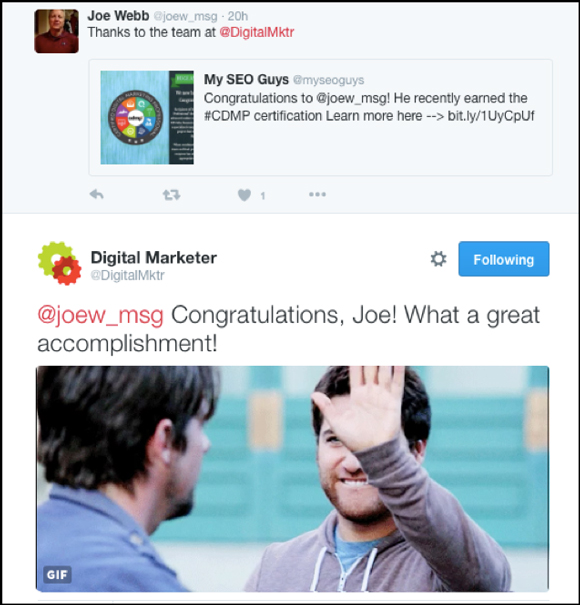
- Use Hootsuite to schedule content from other industry professionals that our audience would find valuable or interesting.
- Read DigitalMarketer’s most recent blog post, and splinter to distribute to our different social channels.
You can see how Jess’ responsibilities are geared toward getting messages from DigitalMarketer out to our customers and providing a human element to our social channels.
Community Management vs. Social Media Management: Why The Difference Matters
Properly defined roles play a critical part in the health of both your company and your employee’s sanity. Want to scale your team easier?
Hire right the first time!
Defining roles will…
- Identify the return on investment. Jobs that are poorly defined are also often poorly measured and poorly rewarded. This is bad news if ROI is at all an important part of your team-building initiatives (hint: it should be).
- Align expectations. Defining roles forces you to align expectations and goals within your company. Whoever you hire, they will have a much less stressful time if they know exactly what outcomes your company expects.
- Avoids burnout. If your Social Media Manager or Community Manager is taking on the responsibilities of both roles– especially if you have a brand new community that needs a lot of TLC and/or a social media strategy you are building from the ground up – you run the risk of stretching your hire too thin.
Take a look at this job posting from Kaiser Permanente, a healthcare provider.
Based on what you’ve just learned on how Social Media and Community Managers communicate, which role do you think this company is seeking to hire?


Fostering user connections behind the scenes? Encourage thought leadership? Establishing a positive environment and encouraging two-way conversations between customers and company?
If you think this screams community management, you’re right:


Now we’ll take a look at another job posting from a test-prep company.
You’ll notice the job description boasts roles of…
- Monitoring public social channels
- Building relationships with influencers
- Creating and publishing content
- Social customer service
- Social listening initiatives
This has Social Media Manager all over it!

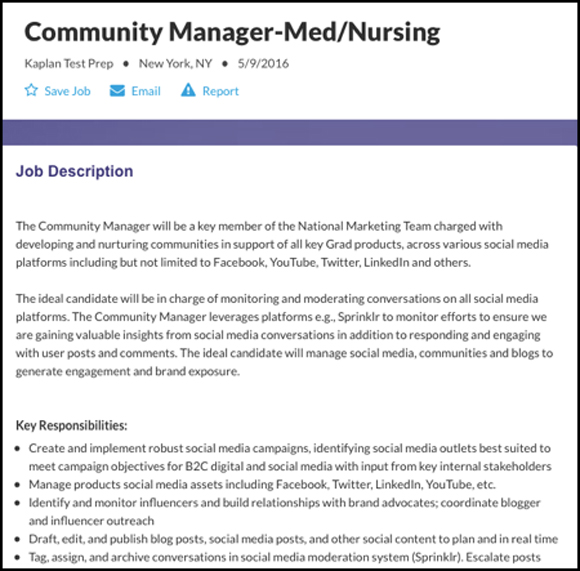
Surprise!
If an experienced Community Manager landed on this role, they would pass for a role that better matches their expertise. An experienced Social Media Manager might not even click the listing in the first place – they are not, after all, specialized in community strategy.
This company might have a hard time finding the right hire for the job.
To sum up, when considering adding a Social Media Manager or a Community Manager to your team ask yourself…
- Who will this hire be talking to?
- What is the return on investment I expect from this role?
- What does success look like?
Answer these questions, and you’re ready to expand your team!













